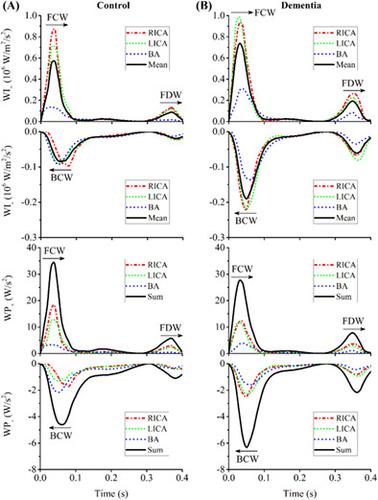当前位置:
X-MOL 学术
›
Int. J. Numer. Method. Biomed. Eng.
›
论文详情
Our official English website, www.x-mol.net, welcomes your
feedback! (Note: you will need to create a separate account there.)
Personalized 0D-1D multiscale hemodynamic modeling and wave dynamics analysis of cerebral circulation for an elderly patient with dementia
International Journal for Numerical Methods in Biomedical Engineering ( IF 2.2 ) Pub Date : 2021-07-22 , DOI: 10.1002/cnm.3510 Xiancheng Zhang 1 , Jia Liu 1 , Zaiheng Cheng 1 , Bokai Wu 1 , Jian Xie 2 , Lin Zhang 2 , Zhijun Zhang 2, 3 , Hao Liu 4
International Journal for Numerical Methods in Biomedical Engineering ( IF 2.2 ) Pub Date : 2021-07-22 , DOI: 10.1002/cnm.3510 Xiancheng Zhang 1 , Jia Liu 1 , Zaiheng Cheng 1 , Bokai Wu 1 , Jian Xie 2 , Lin Zhang 2 , Zhijun Zhang 2, 3 , Hao Liu 4
Affiliation

|
Senile dementia is associated with pronounced alterations in cerebral circulation. A fundamental understanding of intracranial hemodynamics and wave dynamics is essential for assessing dementia risk. Recent findings suggest that higher carotid artery wave intensity (WI) can predict future cognitive impairments in the elderly. However, wave power (WP) is more advantageous for assessing the risk of cognitive impairment and dementia because of its conservative form, which allows quantification of detailed WP distribution among the entire cerebrovascular network. Unfortunately, intracranial hemodynamics and wave dynamics in elderly patients with dementia remain poorly understood due to ethical issues and technical challenges. In this paper, we proposed a novel and easily achievable personalized methodology for the 0D-1D model of cerebral circulation using widely available clinical data on transcranial Doppler ultrasonography velocity, cerebral artery anatomy from magnetic resonance imaging, and brachial artery pressure. Using the proposed model, we simulated the cerebral blood flows and compared the wave dynamics between a healthy elderly subject and one living with dementia. Moreover, we performed a variance-based global sensitivity analysis to quantify the model-predicted WI and WP sensitivity to the uncertainties of model inputs. This provided more precise information for model personalization and further insights into the wave dynamics of cerebral circulation. In conclusion, the proposed personalized model framework provides a practical approach for patient-specific modeling and WI/WP analysis of cerebral circulation through noninvasive clinical data. The wave dynamics features of higher WI and lower WP in cerebral arteries may be an invaluable biomarker for assessing dementia risk.
中文翻译:

老年痴呆患者个性化0D-1D多尺度血流动力学建模及脑循环波动力学分析
老年痴呆症与脑循环的显着改变有关。对颅内血流动力学和波动力学的基本了解对于评估痴呆风险至关重要。最近的研究结果表明,较高的颈动脉波强度 (WI) 可以预测老年人未来的认知障碍。然而,波功率 (WP) 因其保守形式而更有利于评估认知障碍和痴呆的风险,它允许量化整个脑血管网络中详细的 WP 分布。不幸的是,由于伦理问题和技术挑战,老年痴呆患者的颅内血流动力学和波动力学仍然知之甚少。在本文中,我们使用广泛可用的经颅多普勒超声速度、磁共振成像的脑动脉解剖和肱动脉压力的临床数据,为脑循环的 0D-1D 模型提出了一种新颖且易于实现的个性化方法。使用所提出的模型,我们模拟了脑血流,并比较了健康老年受试者和痴呆症患者之间的波动力学。此外,我们进行了基于方差的全局敏感性分析,以量化模型预测的 WI 和 WP 对模型输入不确定性的敏感性。这为模型个性化提供了更精确的信息,并进一步了解脑循环的波动力学。综上所述,所提出的个性化模型框架为通过无创临床数据对脑循环的患者特异性建模和 WI/WP 分析提供了一种实用方法。脑动脉中较高 WI 和较低 WP 的波动力学特征可能是评估痴呆风险的宝贵生物标志物。
更新日期:2021-09-14
中文翻译:

老年痴呆患者个性化0D-1D多尺度血流动力学建模及脑循环波动力学分析
老年痴呆症与脑循环的显着改变有关。对颅内血流动力学和波动力学的基本了解对于评估痴呆风险至关重要。最近的研究结果表明,较高的颈动脉波强度 (WI) 可以预测老年人未来的认知障碍。然而,波功率 (WP) 因其保守形式而更有利于评估认知障碍和痴呆的风险,它允许量化整个脑血管网络中详细的 WP 分布。不幸的是,由于伦理问题和技术挑战,老年痴呆患者的颅内血流动力学和波动力学仍然知之甚少。在本文中,我们使用广泛可用的经颅多普勒超声速度、磁共振成像的脑动脉解剖和肱动脉压力的临床数据,为脑循环的 0D-1D 模型提出了一种新颖且易于实现的个性化方法。使用所提出的模型,我们模拟了脑血流,并比较了健康老年受试者和痴呆症患者之间的波动力学。此外,我们进行了基于方差的全局敏感性分析,以量化模型预测的 WI 和 WP 对模型输入不确定性的敏感性。这为模型个性化提供了更精确的信息,并进一步了解脑循环的波动力学。综上所述,所提出的个性化模型框架为通过无创临床数据对脑循环的患者特异性建模和 WI/WP 分析提供了一种实用方法。脑动脉中较高 WI 和较低 WP 的波动力学特征可能是评估痴呆风险的宝贵生物标志物。











































 京公网安备 11010802027423号
京公网安备 11010802027423号